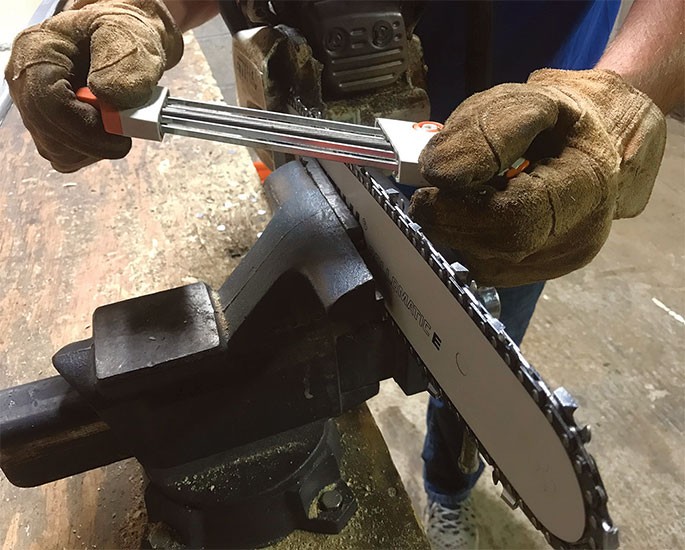
Maintaining a sharp chainsaw chain not only makes for faster cutting, it also reduces wear and tear on the saw and the sawyer. Given those obvious benefits, it still surprises me to see people struggling with dull saws. To compensate for a dull or damaged chain, sawyers often use the felling dogs to create more leverage, or use a comical back-and-forth sawing motion (treating a running chainsaw as if it were a bow saw), which is both unsafe and ineffective.
Here’s a look at some common chainsaw sharpening myths and mistakes:
Using the wrong-size file (specifically for round-tooth chain)
It’s essential to choose a round file that’s the correct size for the pitch of the chain being sharpened. Using the proper size of file allows the filer to adhere to the 80 percent/20 percent rule, by which 80 percent of the file is inside the cutter, and 20 percent is above the cutter, creating a sharp, crescent-shaped hook on the end of the cutter tooth. Using a file that’s too small in diameter will prevent the top edge of the cutter from being sharpened, while a file that’s too large will remove the hook of the tooth, which is essential for efficient cutting. For example, with .325 pitch chain, you should use a 3/16-inch file; for 3/8-inch pitch, use a 5/32-inch file.
Filing the cutters, but not the depth gauge
The depth gauge (rakers) on a chainsaw control how deep the cutter teeth penetrate. Because the top plate of the cutter tooth is angled back slightly, it is essential that the depth gauge be lowered as the cutter teeth are filed back. Failing to file the depth gauge and only filing the cutter teeth will result in smaller and smaller chips with each subsequent sharpening.
Over-filing the depth gauge
Conversely, some people over-file the depth gauge so that the saw takes a bigger chip. The result is that the saw is overworked and bogs down; it also makes the saw prone to kickback.
Using a dull file
Chainsaw chain is extremely hard and requires a sharp file. As you push and add pressure to the file you should feel it grab. If adding pressure causes the file to skate, chances are your file is worn out. If you’re using a filing tool where the file is in a fixed position, remember to regularly rotate the file for even wear.
Not bracing the saw properly
The best way to brace the chainsaw when sharpening is to place the bar in a bench vice. Keep even pressure with each stroke, and keep the number of strokes consistent for each tooth. If sharpening in the field, consider using a stump vice, or brace the tip of the bar on a log and lock the chain brake.
Filing backwards
Always file from the inside of the tooth to the outside, and don’t drag your file backwards. Filing from the outside to the inside will wear out the file in short order since the outside of the tooth is chrome-plated and harder than the file material. You’ll also find it easier to line up the file guide and maintain a more consistent stroke when working from the inside of the tooth.


Discussion *